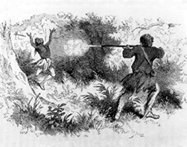Remembering George Leonard Herter and His Catalogue
Books, Cuisine, Field Sports, George Leonard Herter, Herter's Catalogue

The inimitable George Leonard Herter
Back in the 1950s and the 1960s, the annual two-inch thick telephone directory-sized Herter’s catalogue, arriving from far off, exotic Waseca, Minnesota was, for sportsmen, and for small boy aspiring sportsmen, not just a standard source of fishing tackle, camping, handloading, fly tying, trapping, and taxidermy supplies, the Herter’s catalogue was a long term reading treasure providing fodder for countless hours of theoretical expedition planning and equipment acquisition and maintenance.
Paul Collins, in a recent New York Times Book Review, pays tribute to the long-extinct Herter’s catalogue and its colorful and eccentric author. George Leonard Herter’s infamous “Bull Cook and Authentic Historical Recipes and Practices†providing the recipes for the Virgin Mary’s favorite creamed spinach, Joan of Arc’s pate de fois gras, and Stonewall Jackson’s barbecued ribs (among many others) is his personal favorite example of Herteriana.
Starting in 1937 from atop his father’s dry-goods shop in Waseca, Minn., Herter over the next four decades built a mail-order sporting goods juggernaut. The arrival of the Herter’s catalog was like Christmas with bullets. Need a bird’s-eye maple gunstock? Check. How about a Herter’s Famous Raccoon Death Cry Call? Just two dollars. Fiberglass canoes? Got you covered. The catalog, which the former Waseca printer Wayne Brown recalls started as three-ring binder supplements, grew so popular — about 400,000 or 500,000 copies per run, he estimates — that Brown Printing became one of the country’s largest commercial printers.
“Herter wrote all the copy for the catalogs,†Brown said in an e-mail message, and each item was described in loving, haranguing, Barnum-esque detail. No Herter item was merely good: it was World Famous, Patented, Special, “made with infinite care by our most expert old craftsmen,†or — my favorite — “actually made far better than is necessary.†The corollary was that his competitor’s products were worthless — or, as he put it, “like they were made by indifferent schoolgirls.â€
But as good as much of his gear was, talk about Herter always comes around to one thing: his books. His enchantingly bombastic catalogs included listings for more than a dozen of his self-published works, bound in metallic silver and gold covers, and bearing titles like “How to Get Out of the Rat Race and Live on $10 a Month.â€
My understanding is that Herter was put out of business in the 1970s over Jungle Cock. The eyed neck feathers of the Grey Jungle Fowl, Gallus Sonneratti, have long been an essential ingredient in the construction of artificial flies for fishing. The eyed feathers serve as eyes on streamer fly imitations of minnows, and as crucial decorative elements in the visually elaborate salmon fly attractor patterns originated in the Victorian era.
Federal enforcement of a ban on the trade in feathers of endangered species took no cognizance of material stockpiles dating to periods long before the ban, and George Leonard Herter was a classic American individualist and a hard core sportsman who simply could not bow to irrational regulation. The reports I heard were that federal lawsuits and seizures, based on one small particular type of feather entirely legally owned and acquired in the first place, ruined the famous company and broke its proprietor’s heart. He never even tried to revive his business.
Had it survived, just imagine how enormous a business Herter’s would be today! Herter’s would be today’s Cabela’s and more.
————————
Hat tip to Karen L. Myers.



